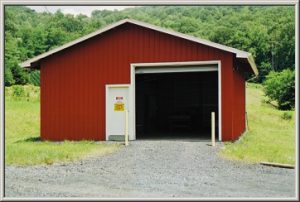The first steps in preventing pesticide spills are education and planning. Most pesticide spills occur in areas where the concentrated product is handled. Areas such as loading docks, storage, and mixing areas are high risk zones. Concentrate your precautionary measures on providing adequate storage facilities, instituting monthly inspection of pesticide storage, stocking emergency equipment for spill cleanup and providing training for all pesticide handlers.
 Most applicators use existing buildings, or areas within existing buildings, for pesticide storage. However, if you use large amounts of pesticides and/or equipment, it would be best to build a special storage facility just for your pesticide needs. If possible, use a separate building for your pesticide storage. If you do not have a separate structure, choose a wing or corner on the first floor of a building.
Most applicators use existing buildings, or areas within existing buildings, for pesticide storage. However, if you use large amounts of pesticides and/or equipment, it would be best to build a special storage facility just for your pesticide needs. If possible, use a separate building for your pesticide storage. If you do not have a separate structure, choose a wing or corner on the first floor of a building.
Before you build a new structure, look into suggestions and plans for pesticide storage put out by state colleges, chemical companies, county extension agents, etc. When you are setting up any new storage, check federal, state, and local regulations on storage areas. Refer to the Pesticide Storage page on this web site.
The mixing and loading area must be carefully chosen. It should be outside, away from other people, livestock, and pets. Pesticides should not be mixed in areas where a spill or overflow could get into a water supply. If possible, mix and load pesticides on a concrete pad so that spilled pesticides can be removed without entering the soil. Because of the need for water, handling areas frequently must be near a pond or stream bank. If this is the case, grade the slope away from the water. If you must work indoors, or at night, be sure there is adequate ventilation and light to minimize the chance for an accident. Have a supply of clean water and soap available and, if possible, do not work alone.
Training program
- Train all employees in proper handling procedures during:
- Receiving
- Storage
- Mixing
- Loading
- Application
- Disposal
- Spill containment and cleanup
- Train pesticide handlers in proper spill prevention, emergency response and containment of pesticide spills.
- Drill and rehearse spill handling procedures regularly to prepare pesticide handlers to respond appropriately to an accident.
Facility Management
- Identify locations and work procedures where spills are likely to occur.
- Take steps to improve spill-prone areas, such as improving storage and mixing facilities for all pesticides.
- Properly secure pesticides in vehicles for transport.
- Inspect storage areas for leaks and for damaged containers on a scheduled basis.
- Make sure that emergency equipment is on hand in case a spill occurs.
- Post emergency phone numbers.
- Post emergency procedures near work areas.
More information on spill prevention:
Original content compiled by:
